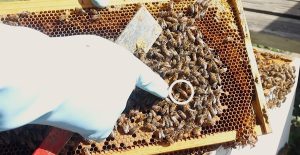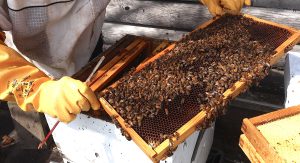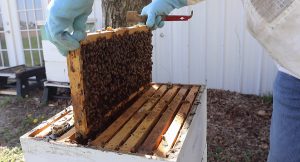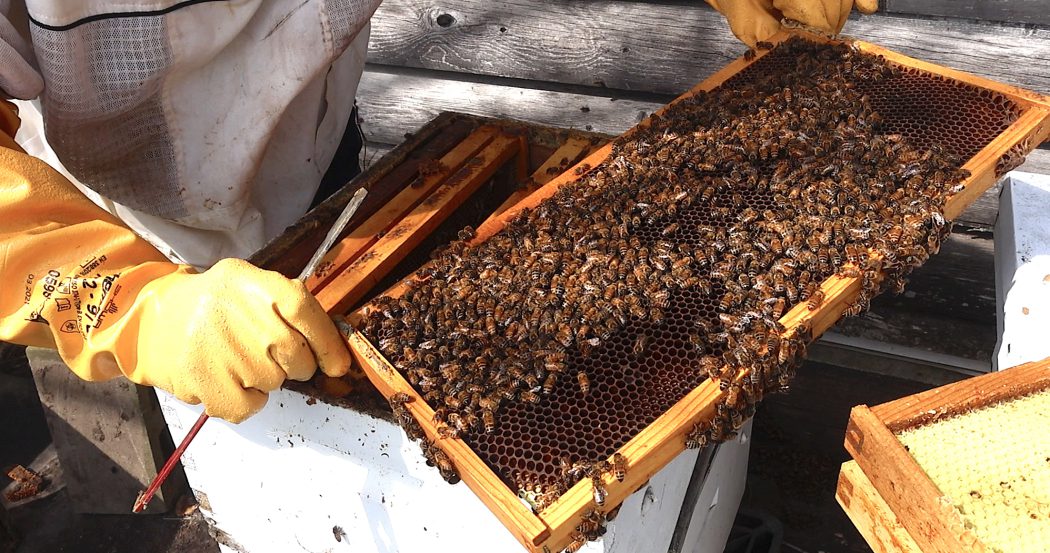By: David Burns
 From the moment we start our hive inspection, the thrill of searching for the queen consumes us. It’s a grand adventure, a quest for the ages, and the longer we look without success, the more determined we become to find her royal highness. When we come up empty-handed, we can’t help but feel a sense of disappointment and concern for the well-being of the colony. Has she vanished? Will they survive without her?
From the moment we start our hive inspection, the thrill of searching for the queen consumes us. It’s a grand adventure, a quest for the ages, and the longer we look without success, the more determined we become to find her royal highness. When we come up empty-handed, we can’t help but feel a sense of disappointment and concern for the well-being of the colony. Has she vanished? Will they survive without her?
Yet, the moment we finally lay eyes on our queen, a wave of relief washes over us, and we are reassured that all is right in our little apiary, if not the world at large. The satisfaction of this ultimate discovery is a feeling that never grows old. But let’s ask ourselves: is finding the queen really so vital? For a novice beekeeper, locating one bee among 40-60,000 can seem an impossible task.
Most inspections do not require that we see our queen. Instead, evaluating her laying pattern is often all we need to confirm that all is well. Do we see a sufficient number of eggs, larvae and a good brood pattern of capped over larvae? Once we confirm the brood looks good, there is really no need to spend more time trying to find the queen.
However, there are certain situations when it becomes necessary. For instance, when the queen’s offspring display aggression or she’s producing a subpar brood pattern, it may be time to replace her. We can’t risk introducing a new queen without first finding and removing the old queen. During the Spring season, I typically create one or two splits from each colony, and this involves removing and placing the original queen in the new split to mitigate swarming behavior in the original hive.
While filming a recent YouTube video, I found myself needing to create a split by removing frames of brood and resources, while also relocating the original queen. However, there was one major issue: the hive was extremely aggressive. To describe it aptly, this colony was what beekeepers refer to as “hot”. Unlike other hives that I can manage wearing just a hat and veil, working with this particular hive necessitated the use of a complete bee suit and sting-proof gloves.
In colonies like this, you can limit your time searching for the queen by only looking for her on frames of open brood. Rarely will she be spotted on a frame of nectar, honey or pollen. Once you see one-day-old eggs, standing straight up in cells, the queen is likely to be in close proximity.
 Need to find the queen in a hot hive? These tips might come in handy.
Need to find the queen in a hot hive? These tips might come in handy.
1. Wear More Than Enough Protective Gear
This is no time to earn bragging rights of how you work your bees in sandals, shorts and a tank top with no hat or veil. Keeping a defensive colony calm is tricky and if you take one or two stings, the alarm pheromone can attract more stings. The alarm pheromone’s main component is isopentyl acetate, a similar odor found in bananas. Even accidentally smashing a bee can release the alarm pheromone. So, avoid stings by suiting up, and carefully try not to kill any bees.
2. Work Your Defensive Hive Last
If you have several hives that are tolerable, but one is very defensive always work your defensive hive last. If you work it first, these defensive bees will follow you and can attract higher than usual defensive responses from your other colonies. You will want to end your time in the apiary with your defensive colony.
3. Lots of Smoke
Not only do I have my smoker going at 100% capacity, but I have spare burlap smoker fuel in every pocket of my bee suit. Of course, more smoke can keep the queen on the run making her more difficult to find, but there is no choice. These bees respond well to smoke.
4. Work in Slow Motion
Honey bees possess incredible visual capabilities. In fact, a single compound eye of a worker bee contains approximately 6,900 intricate facets or miniature lenses. This remarkable feature allows them to seamlessly integrate mosaic images and effectively detect swift movements. As beekeepers, we can use this knowledge to our advantage by handling the bees more cautiously and minimizing any sudden actions. This becomes an absolute necessity when dealing with a defensive hive.
 5. Carry Parts of The Hive Away
5. Carry Parts of The Hive Away
When working a very defensive hive and I must continue inspecting 20-30 frames to find the queen, I find it is best to carry one deep hive body twenty feet away. Once I remove it from the hive location and the other hive box, the bees become calmer to work. Moving the boxes apart also prevents the queen from walking up or down into the other hive body.
Finding the queen in a hot hive can be a challenging task, but once located, it brings a sense of satisfaction, especially when it’s time to replace her with a queen that produces gentler offspring. After approximately 45 days, the aggressive bees will perish naturally, making room for a new generation of bees with a more docile temperament. These tips will not only be helpful when working a defensive colony, but can also help every inspection go much better, even in gentle colonies.
If you’d like to watch my YouTube video of this inspection visit: https://www.honeybeesonline.com/davids-youtube-channel









